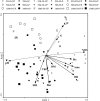Impact of metal pollution and Thlaspi caerulescens growth on soil microbial communities
- PMID: 20935131
- PMCID: PMC2988604
- DOI: 10.1128/AEM.01045-10
Impact of metal pollution and Thlaspi caerulescens growth on soil microbial communities
Abstract
Soil microorganisms drive critical functions in plant-soil systems. As such, various microbial properties have been proposed as indicators of soil functioning, making them potentially useful in evaluating the recovery of polluted soils via phytoremediation strategies. To evaluate microbial responses to metal phytoextraction using hyperaccumulators, a microcosm experiment was carried out to study the impacts of Zn and/or Cd pollution and Thlaspi caerulescens growth on key soil microbial properties: basal respiration; substrate-induced respiration (SIR); bacterial community structure as assessed by PCR-denaturing gradient gel electrophoresis (DGGE); community sizes of total bacteria, ammonia-oxidizing bacteria, and chitin-degrading bacteria as assessed by quantitative PCR (Q-PCR); and functional gene distributions as determined by functional gene arrays (GeoChip). T. caerulescens proved to be suitable for Zn and Cd phytoextraction: shoots accumulated up to 8,211 and 1,763 mg kg(-1) (dry weight [DW]) of Zn and Cd, respectively. In general, Zn pollution led to decreased levels of basal respiration and ammonia-oxidizing bacteria, while T. caerulescens growth increased the values of substrate-induced respiration (SIR) and total bacteria. In soils polluted with 1,000 mg Zn kg(-1) and 250 mg Cd kg(-1) (DW), soil bacterial community profiles and the distribution of microbial functional genes were most affected by the presence of metals. Metal-polluted and planted soils had the highest percentage of unique genes detected via the GeoChip (35%). It was possible to track microbial responses to planting with T. caerulescens and to gain insight into the effects of metal pollution on soilborne microbial communities.
Figures



References
-
- Assunção, A. G. L., H. Schat, and M. G. M. Aarts. 2003. Thlaspi caerulescens, an attractive model species to study heavy metal hyperaccumulation in plants. New Phytol. 159:351-360. - PubMed
-
- Baker, A. J. M., S. P. McGrath, R. D. Reeves, and J. A. C. Smith. 2000. Metal hyperaccumulator plants: a review of the ecology and physiology of a biological resource for phytoremediation of metal-polluted soils, p. 85-107. In N. Terry and G. Bañuelos (ed.), Phytoremediation of contaminated soil and water. Lewis Publishers, Boca Raton, FL.
-
- Brim, H., H. Heuer, E. Krögerrecklenfort, M. Mergeay, and K. Smalla. 1999. Characterization of the bacterial community of a zinc-polluted soil. Can. J. Microbiol. 45:326-338. - PubMed
-
- Cunningham, S. D., and W. R. Berti. 1993. Remediation of contaminated soils with green plants: an overview. In Vitro Cell Dev. Biol. 29:207-212.
-
- Duxbury, T. 1985. Ecological aspects of heavy metal responses in microorganisms, p. 185-236. In K. C. Marshall (ed.), Advances in microbial ecology, vol. 8. Plenum, New York, NY.
Publication types
MeSH terms
Substances
LinkOut - more resources
Full Text Sources
Research Materials

